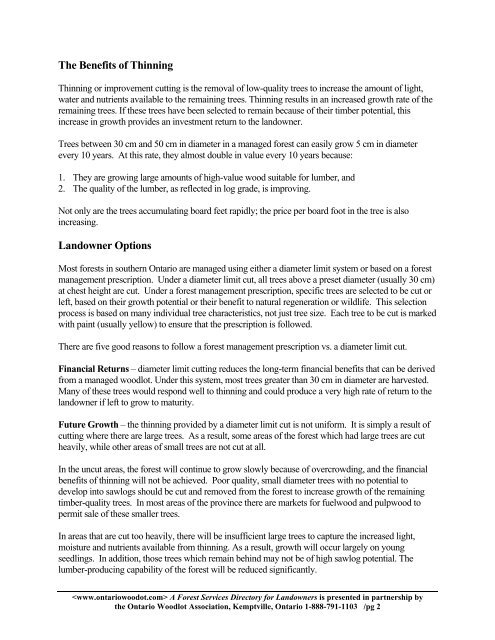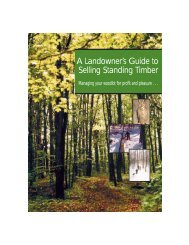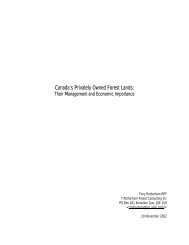Forest Management for Income - Ontario woodlot.com
Forest Management for Income - Ontario woodlot.com
Forest Management for Income - Ontario woodlot.com
Create successful ePaper yourself
Turn your PDF publications into a flip-book with our unique Google optimized e-Paper software.
The Benefits of ThinningThinning or improvement cutting is the removal of low-quality trees to increase the amount of light,water and nutrients available to the remaining trees. Thinning results in an increased growth rate of theremaining trees. If these trees have been selected to remain because of their timber potential, thisincrease in growth provides an investment return to the landowner.Trees between 30 cm and 50 cm in diameter in a managed <strong>for</strong>est can easily grow 5 cm in diameterevery 10 years. At this rate, they almost double in value every 10 years because:1. They are growing large amounts of high-value wood suitable <strong>for</strong> lumber, and2. The quality of the lumber, as reflected in log grade, is improving.Not only are the trees accumulating board feet rapidly; the price per board foot in the tree is alsoincreasing.Landowner OptionsMost <strong>for</strong>ests in southern <strong>Ontario</strong> are managed using either a diameter limit system or based on a <strong>for</strong>estmanagement prescription. Under a diameter limit cut, all trees above a preset diameter (usually 30 cm)at chest height are cut. Under a <strong>for</strong>est management prescription, specific trees are selected to be cut orleft, based on their growth potential or their benefit to natural regeneration or wildlife. This selectionprocess is based on many individual tree characteristics, not just tree size. Each tree to be cut is markedwith paint (usually yellow) to ensure that the prescription is followed.There are five good reasons to follow a <strong>for</strong>est management prescription vs. a diameter limit cut.Financial Returns – diameter limit cutting reduces the long-term financial benefits that can be derivedfrom a managed <strong>woodlot</strong>. Under this system, most trees greater than 30 cm in diameter are harvested.Many of these trees would respond well to thinning and could produce a very high rate of return to thelandowner if left to grow to maturity.Future Growth – the thinning provided by a diameter limit cut is not uni<strong>for</strong>m. It is simply a result ofcutting where there are large trees. As a result, some areas of the <strong>for</strong>est which had large trees are cutheavily, while other areas of small trees are not cut at all.In the uncut areas, the <strong>for</strong>est will continue to grow slowly because of overcrowding, and the financialbenefits of thinning will not be achieved. Poor quality, small diameter trees with no potential todevelop into sawlogs should be cut and removed from the <strong>for</strong>est to increase growth of the remainingtimber-quality trees. In most areas of the province there are markets <strong>for</strong> fuelwood and pulpwood topermit sale of these smaller trees.In areas that are cut too heavily, there will be insufficient large trees to capture the increased light,moisture and nutrients available from thinning. As a result, growth will occur largely on youngseedlings. In addition, those trees which remain behind may not be of high sawlog potential. Thelumber-producing capability of the <strong>for</strong>est will be reduced significantly. A <strong>Forest</strong> Services Directory <strong>for</strong> Landowners is presented in partnership bythe <strong>Ontario</strong> Woodlot Association, Kemptville, <strong>Ontario</strong> 1-888-791-1103 /pg 2
















